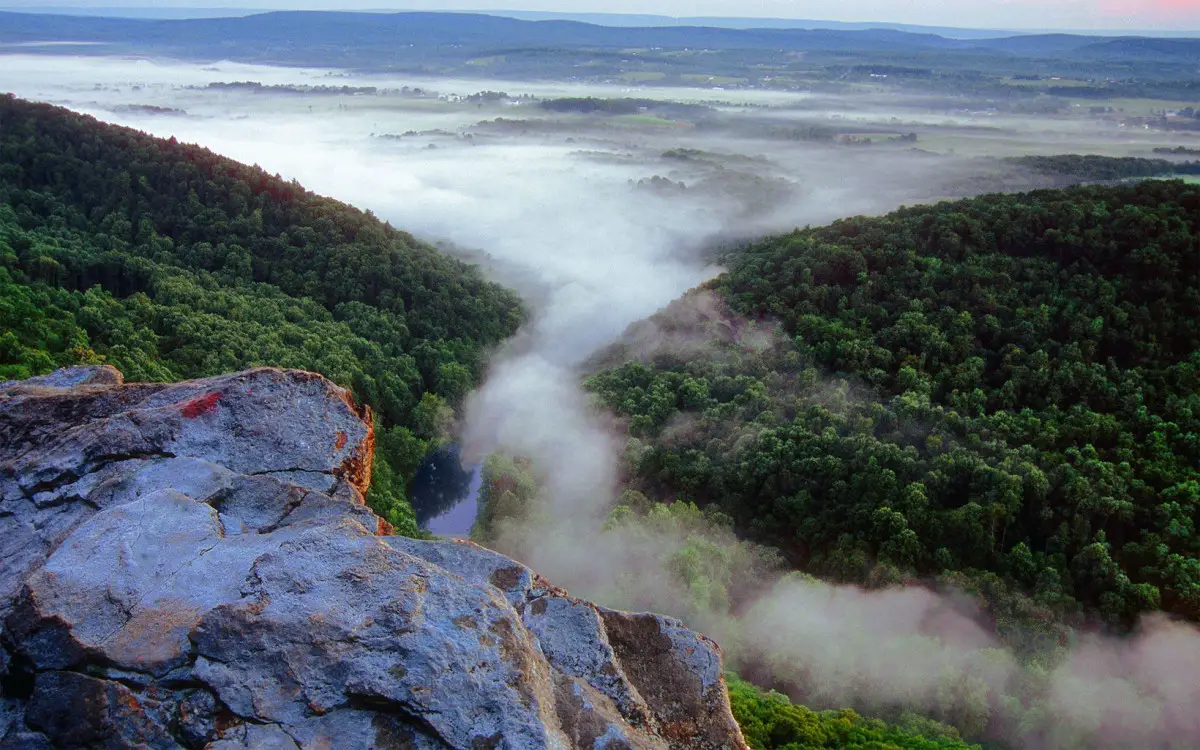You might not have thought, but the Appalachian Mountains are considered among the oldest mountains in the world, according to the U.S. Geological Survey, the river system that is contained within basins is even older, and the water rose with them as they formed. What is the oldest river in the United States?
New River: considered the oldest U.S.River
- Age: ~300 million yrs.
- Location: North Carolina, Virginia, West Virginia
- Geological Evidence: Predates Appalachian Mountains
- Dating Method: Isotopic studies of bedrock/sediments
- Unique Path: Flows northward
- Ecological Role: Supports diverse life & offers insight into Earth’s history
Introduction:
Rivers carry with them the ancient tales of our planet’s geological and environmental past. In the United States, some of the oldest rivers have been shaping their courses for hundreds of millions of years, acting as natural historians of the changes that have occurred. Thanks to modern techniques such as chemical analysis and isotopic dating, scientists have uncovered intriguing details about the age and development of these waterways. This article takes a closer look at the oldest rivers in the U.S., examining their origins, the evidence provided by recent scientific research, and their wider ecological importance.

Oldest River in the United States
The New River, spanning North Carolina, Virginia, and West Virginia, is widely regarded as the oldest river in the United States, with an estimated age of approximately 300 million years. Geological evidence suggests it predates the Appalachian Mountains, which were formed during the collision of tectonic plates in the late Paleozoic era.
Isotopic studies of its bedrock and sediments confirm its ancient origins, revealing a history intertwined with the supercontinent Pangaea. Unlike most U.S. rivers, the New River flows northward, a path likely shaped before major geological shifts. Its ancient course has supported diverse ecosystems and offers invaluable insights into Earth’s tectonic and climatic history.
Understanding River Age
Figuring out how old a river is involves a lot more than just tracking its water flow. Scientists concentrate on how the river valley formed and the bedrock it runs over. They use several key methods, such as geological mapping to study rock formations and their histories, and isotopic dating, which applies radiometric techniques to find out the ages of minerals and sediments.
Additionally, chemical analysis of sediment layers can shed light on past environmental conditions, tectonic activity, and weathering processes. By combining these approaches, scientists can piece together a river’s historical journey, often discovering that many rivers are older than the mountains or landscapes they pass through.
Determining a river’s age is a complex process, often involving:
- Geological mapping: Studying the rock formations along river valleys.
- Isotopic dating: Using radiometric techniques to date sediment and rocks.
- Chemical analysis: Understanding sediment composition for historical reconstruction.
The age of a river doesn’t necessarily reflect the water flowing through it but instead refers to the river valley’s formation or its bedrock’s antiquity.

The Oldest Rivers in the U.S.
The United States is home to some of the world’s oldest rivers, with geological histories dating back hundreds of millions of years. Among them, the New River, spanning North Carolina, Virginia, and West Virginia, is often considered one of the oldest at approximately 300 million years old. Remarkably, it predates the Appalachian Mountains, as evidenced by isotopic studies that confirm its age and sediment consistency.
The New River flows for 320 miles from the Blue Ridge Mountains of North Carolina northwest into Virginia and West Virginia, where it eventually connects with the Kanawha River. The river system is contained within basins in the Appalachian Mountains, and some scientists believe it is older than these mountains and that the water rose with them as they formed.
Similarly, the Susquehanna River, flowing through Pennsylvania, Maryland, and New York, is estimated to be 250–300 million years old. Radiometric dating reveals its formation during the breakup of the supercontinent Pangaea, supported by chemical analyses of sediments aligning with ancient geological features.
The French Broad River, which winds through North Carolina and Tennessee, also boasts an ancient history, with an estimated age of 200–300 million years. Geological studies suggest its path was established before the Appalachian Mountains began to rise, and volcanic sediment deposits in its basin confirm its prehistoric origin.
The James River in Virginia, dating back around 200 million years, completes the list of the U.S.’s ancient rivers. Carbon isotope studies and the presence of Triassic and Jurassic sedimentation underscore its longevity. Together, these rivers represent invaluable natural records of Earth’s tectonic and climatic history.
1. The New River
- Location: North Carolina, Virginia, West Virginia.
- Estimated Age: ~300 million years.
- Scientific Insights: Geological studies suggest that the New River pre-dates the Appalachian Mountains. Recent isotopic studies reveal a consistent age of sediments along the river’s path.
The New River was formed before the Triassic Period nearly 252 million years ago. Many point to the New River Gorge Bridge when the thought of the New River pops up. However, the New River Gorge National Park and Preserve houses only 53 miles of the river that originates south of the Mountain State. Before the rise of the Appalachian Mountains, the New River cut its bed at a time when the land sloped to the northwest.
Amazingly so, as the Appalachians gradually rose around the river, the New River wore away the bedrock at the same rate the mountains formed, leaving behind towering cliffs and prominences that hovered hundreds of feet above the water level.
When looking abroad at other rivers around the world, the New River remains in the top-5 oldest rivers at the number four spot. Encompassing over 70,000 acres, 10,000 acres of which is established as a National Park, the recreation area is situated along 53 miles of wild river flowing through a 1,000-foot deep gorge.
2. The Susquehanna River
- Location: Pennsylvania, Maryland, New York.
- Estimated Age: ~250-300 million years.
- Scientific Insights: Radiometric dating of its bedrock indicates its formation during the breakup of the supercontinent Pangaea. Chemical analyses of sediments have shown similarities with ancient geological formations.
The Susquehanna River is the potential source of waterpower in the eastern United States; hydroelectric power plants have been built at Holtwood, York Haven, Safe Harbor, Pennsylvania, and Conowingo, Maryland. Main riverine cities include Binghamton, New York, Wilkes-Barre, Scranton (on the Lackawanna), Williamsport (on the West Branch), and Harrisburg, Pennsylvania
3. The French Broad River
- Location: North Carolina, Tennessee.
- Estimated Age: ~200-300 million years.
- Scientific Insights: Its path suggests that it predates the Appalachian uplift. Modern studies highlight the presence of ancient volcanic sediment deposits in its basin.
This ancient river is believed to be the third oldest in the world, around 250 million years old. It is one of the few rivers that flows north. The Cherokee called it Agiqua or “Long Man”, an apt name as the entire watershed contains over 4,000 miles of rivers and streams.
4. The James River
- Location: Virginia.
- Estimated Age: ~200 million years.
- Scientific Insights: Triassic and Jurassic sedimentation traces have been identified using carbon isotope studies.
It is 340 miles long and is fed by 15,000 miles of tributaries. The James River watershed encompasses approximately 10,000 square miles and is comprised of three sections: the Lower, Middle, and Upper James Rivers.
Why are Ancient Rivers Important to Study
Ancient rivers are vital to study because they provide:
- Geological History: Reveal Earth’s tectonic, volcanic, and erosional processes over millions of years.
- Climate Insights: Help reconstruct past climates and environmental changes.
- Biodiversity: Support unique ecosystems that evolved alongside their ancient paths.
- Sediment Records: Store information about past vegetation, weathering, and erosion.
- Tectonic Activity: Offer evidence of mountain formation, continental drift, and landmass changes.
- Water Resource Management: Guide sustainable usage by understanding river longevity and sedimentation.
- Cultural Significance: Many ancient rivers have been central to human settlement and development.
- Conservation Needs: Highlight vulnerabilities like pollution, helping inform preservation efforts.
Studying them is a window into Earth’s past and a guide for future environmental management.

Chemical Analysis and Scientific Validation
Modern scientific techniques have revolutionized our understanding of river systems, particularly in dating and validating the ages of ancient rivers. Chemical analysis plays a central role, offering insights into sediment composition, isotopic signatures, and geological stability over time.
One powerful tool is the use of strontium isotopes, which are highly effective in identifying the age of sediments and bedrock. For instance, strontium isotope ratios in the New and Susquehanna Rivers align with rocks dating back to the late Carboniferous period (~300 million years ago). This finding confirms their existence long before significant geological upheavals, such as the Appalachian uplift.
Additionally, the elemental composition of river sediments provides critical clues about historical volcanic and tectonic activity. In the French Broad River, researchers have detected traces of ancient volcanic sediments, further substantiating its age and geological formation.
Radiocarbon dating complements these methods by analyzing organic materials embedded in sediment layers. This technique has helped establish timelines for depositional events and periods of significant river valley erosion.
Recent studies, such as a 2023 publication in Earth Science Reviews, emphasize how these tools together validate the estimated ages of rivers. The New River’s isotopic analysis and chemical weathering profiles, for example, consistently indicate stability dating back hundreds of millions of years. These scientific advancements not only uncover the histories of these waterways but also enhance our understanding of Earth’s dynamic processes over geological timescales.
Recent Advances in Chemical Analysis
- Strontium Isotopes: These have been critical in pinpointing sediment ages in rivers like the New and Susquehanna.
- Elemental Composition: Rivers such as the French Broad show unique traces of ancient volcanic activity.
- Radiocarbon Dating is essential in determining the historical timelines of organic material and sediment layers.
Example Analysis
In a 2023 study published in Earth Science Reviews, researchers found:
- The New River’s isotopic signature aligns with rocks dated to the late Carboniferous period (~300 million years ago).
- Chemical weathering profiles indicate significant stability of these rivers through tectonic and climatic shifts.
Conclusion:
The oldest rivers in the U.S. are more than ancient waterways; they are living chronicles of Earth’s geological history. Advances in chemical and isotopic analysis have enabled scientists to unlock their secrets, revealing their enduring resilience. As we continue to study these natural wonders, they serve as reminders of the interconnectedness between the Earth’s past and our present-day environment. Understanding and preserving these ancient rivers is not only a geological pursuit but also an ecological necessity for future generations.
References:
National Parks Conservation Association- The Oldest River in North America?
FAQ’s



